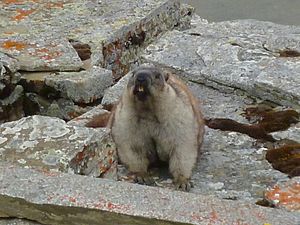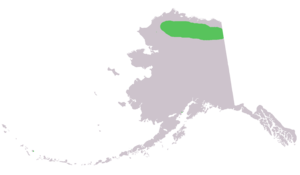Alaska marmot facts for kids
Quick facts for kids Alaska marmot |
|
|---|---|
 |
|
| Conservation status | |
| Scientific classification | |
| Genus: |
Marmota
|
| Species: |
broweri
|
 |
|
| Range of Marmota broweri in Alaska. Its range also extends slightly into Canada. | |
The Alaska marmot (Marmota broweri), also known as the Brooks Range marmot or the Brower's marmot, is a type of rodent in the squirrel family (Sciuridae). These furry animals live on the rocky slopes of the Brooks Range in Alaska.
Alaska marmots enjoy eating grass, flowering plants, berries, roots, moss, and lichen. They are about 54 centimetres (21 in) to 65 centimetres (26 in) long and weigh between 2.5 kilograms (5.5 lb) and 4 kilograms (8.8 lb). Alaska even celebrates "Marmot Day" on February 2, a special holiday to recognize these unique animals instead of Groundhog Day.
Contents
About the Name
The Alaska marmot, Marmota broweri, was once thought to be the same as another marmot species. However, scientists later found clear evidence that M. broweri is its own special species. They used special genetic tests to confirm this.
History and Marmot Day
For a long time, Alaskan Native people have hunted Alaska marmots. They used the marmots for food and their warm fur. It could take about 20 marmot furs to make just one warm winter coat called a parka.
Marmot Day is like Alaska's own version of Groundhog Day. In 2009, Sarah Palin, who was the governor of Alaska, signed a bill to make February 2 officially Marmot Day. Senator Linda Menard introduced this idea. She thought it made sense for the marmot to be Alaska's special animal, similar to Punxsutawney Phil, the famous groundhog. The goal of Marmot Day is to create fun learning activities about marmots, not to predict the weather.
Status in the Wild
It's a bit tricky to study Alaska marmots because they live in hard-to-reach places. However, experts believe their population is stable. The IUCN (International Union for Conservation of Nature) says the Alaska marmot is of "least concern." This means they are not currently in danger. Even though some are hunted, their numbers are healthy. In fact, the Alaska marmot is considered the least threatened of all marmot species.
What They Look Like
General Appearance
Alaska marmots are mammals with a thick body covered in coarse hair. They have a short neck, a broad head, and a bushy tail. Their ears are small, and their legs and feet are short and strong.
Adult Alaska marmots usually have dark fur on their nose and the top of their head. Their feet can be light or dark. They have tough claws that are great for digging. However, their thumbs have flat nails instead of claws. Their size can change a lot depending on their hibernation cycles. Male marmots are typically about 61 centimetres (24 in) long and weigh around 3.6 kilograms (7.9 lb). Females are a bit smaller, usually about 58 centimetres (23 in) long and weighing 3.2 kilograms (7.1 lb).
Special Features
Alaska marmots have eyes that don't see well at night. Their eyes are placed in a way that gives them a very wide view to the sides and upwards. All of their teeth, especially their sharp front teeth (incisors), keep growing throughout their lives. They have one pair of incisors in their upper jaw and one pair in their lower jaw.
Where They Live and What They Do
Location and Home Range
Alaska marmots are found in the northern parts of the world, specifically in the Brooks Range, Ray Mountains, and Kokrines Hills in Alaska. They live in the mountains north of the Yukon and Porcupine rivers in central and northern Alaska. There have also been reports of them in the Richardson Mountains in Canada, but these sightings need to be confirmed.
Alaska marmots live in small groups called colonies, scattered across Alaska. These colonies are made up of different families. They have been seen from Lake Peters to Cape Lisburne and Cape Sabine in the Brooks Range. They've also been spotted near rivers in the Northern Baird mountains and in the Mulik Hills.
Their Habitat
Alaska marmots live in cold, polar places like the tundra and mountain areas. They are usually found at elevations of about 1,000 metres (3,300 ft) to 1,250 metres (4,100 ft). They often live in rocky areas like boulder fields, rock slides, and Talus slopes in the mountains. These areas have lots of plants for them to eat.
They often make their homes near lakes on mountain slopes. To build their shelters, Alaska marmots dig burrows into the frozen ground, which has tundra plants. They often have a rocky spot nearby that they use as a lookout. Marmot colonies use the same winter dens for many years, sometimes for over twenty years. Their dark fur helps them blend in with their rocky surroundings. Wind is also important because it helps keep annoying mosquitoes away. If there are too many mosquitoes, marmots might stay in their dens until the wind picks up.
What They Eat
Alaska marmots mainly eat plants that grow on mountain sides in the tundra. This includes grasses, flowers, fruits, grains, and legumes. Sometimes, they might also eat insects. They need to eat a lot of these arctic plants because they don't have much nutrition. This helps them get ready for their long winter sleep. Alaska marmots are generally considered omnivores, meaning they eat both plants and sometimes insects.
Who Hunts Them
Common predators of the Alaska marmot include wolverines, gray wolves, grizzly bears, coyotes, foxes, and eagles. Eagles are the main predators for young marmots.
Dangers They Face
While humans don't disturb them much directly, climate change is a real concern. The Alaska marmot is very sensitive to changes in the environment caused by humans, especially climate change.
Their Impact on the Ecosystem
Marmots help the environment in a few ways. They enrich the soil with uneaten food, nesting materials, and their waste. Their digging also helps to loosen and aerate the soil. They also serve as a food source for various predators.
Their Behavior
Social Life
Alaska marmots are very social animals. They live in colonies that can have up to 50 marmots, all sharing a large system of burrows. Usually, each marmot has its own personal den. Young marmots live with their mother, and the father lives in a nearby den.
In larger colonies, Alaska marmots take turns being "sentries" or lookouts. A sentry marmot will make a loud, two-toned, high-pitched warning call (listen to marmot vocalizations here) if a predator is nearby. Older marmots will defend the colony and keep watch while the young ones play. Dens dug only in dirt offer limited protection. However, dens built under rocks and boulders can protect them from large animals like grizzly bears, who can dig marmots out of dirt dens.
M. broweri also mark their territory. They have special glands on their face that release a substance. They rub the sides of their face on rocks around their den and along their trails to leave their scent. Alaska marmots also enjoy sunbathing and spending a lot of time grooming themselves.
Hibernation
The Alaska marmot is one of the marmot species that hibernates for the longest time, sometimes up to eight months each year. By late summer, they build up a thick layer of fat to help them survive through the winter hibernation.
Alaska marmots stay active until snow starts to fall. Then, they go into their special winter dens, called hibernacula, from around September until June. These winter dens have only one entrance, which they plug up with dirt, plants, and even their waste for the entire winter. These dens are built on exposed ridges that melt earlier than other areas. The whole colony stays inside the den from September until the plug melts in early May. They then settle into their dens in family groups to hibernate together.
Hibernating together might be a way for them to save energy and keep their body temperatures above freezing. During hibernation, many of their body functions slow down. Their body temperature drops (averaging between 4.5 °C (40.1 °F) and 7.5 °C (45.5 °F)), and their heart rate, breathing, and metabolism all decrease. Alaska marmots don't hibernate continuously; they wake up every three or four weeks to go to the bathroom. Inside their winter den, Alaska marmots can handle high levels of carbon dioxide and low levels of oxygen, which helps them survive the long winter.
As an adaptation to the cold Arctic and frozen ground, Alaska marmots actually breed before they fully emerge from their winter dens. They usually come out of their dens during the first two weeks of May.
Reproduction
Male Alaska marmots are polygynous, meaning they mate with several females who live in their territory. They breed once a year in early spring. About six weeks later, the females give birth to litters of 3 to 8 pups, with an average of 4–5 pups. Both the male and female marmots help raise and protect the pups in their burrow.
Before giving birth, the female will close off her den and give birth alone. The pregnancy lasts about 5–6 weeks. Newborn Alaska marmots are altricial, meaning they are born without hair, teeth, and are blind, making them very vulnerable. After about six weeks, the young marmots grow thick, soft fur and start to leave the den for short periods. They will change their fur three times in their first year until they get their adult coat. They will hibernate and live with their parents for at least one year. They become fully grown after two years and can start having their own babies when they are 2 to 3 years old. The lifespan of marmots is not fully known, but it is believed to be about 13–15 years.
See Also
- Marmot Day


